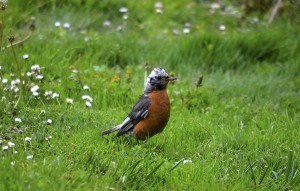 Jasper is home to some ravens with big personalities. ThereÔÇÖs the dancing couple that peck at the Legion windows, and the big scruffy guy that squawks at Discovery Trail users from behind the west-end Petro Canada. And on Aspen Avenue, often hanging out in my friend PauletteÔÇÖs yard is a raven sheÔÇÖs named Markus. YouÔÇÖll know him if you see him.
Jasper is home to some ravens with big personalities. ThereÔÇÖs the dancing couple that peck at the Legion windows, and the big scruffy guy that squawks at Discovery Trail users from behind the west-end Petro Canada. And on Aspen Avenue, often hanging out in my friend PauletteÔÇÖs yard is a raven sheÔÇÖs named Markus. YouÔÇÖll know him if you see him.
Though the majority of his wings are the usual blue-black weÔÇÖd expect to find on a raven, Markus also has an occasional white feather jutting from his back and wings. WhatÔÇÖs going on here?
We know Markus isnÔÇÖt ÔÇťpart albino.ÔÇŁ That would be like being ÔÇťpart pregnantÔÇŁ ÔÇô not possible. If Markus were albino, he would have no pigment at all in his feathers and skin. Even his eyes would lack pigment, instead appearing pink from the blood vessels running through them. Markus would been completely white from birth.
Instead, Markus may have a condition called leucism, one of the most common causes of abnormal colouration in birds. What is leucism? To answer that weÔÇÖll need to crank up the geek-o-meter (or should I say ÔÇťbeak-o-meterÔÇŁ) and begin with a short course of bird colouration.
There are three kinds of pigments that colour feathers. First up, the porphyrins. They make feathers ┬áfluoresce when exposed to ultraviolet light. These can appear pink, brown, red and green. Pigeons have these. Next time youÔÇÖre near the train station or the old Firehall, check them out.
Melanins and carotenoids are the two other pigments. We have these too. In our skin, carotenoids (think beta-carotene) play a number of roles, including protecting our skin from ageing. Melanin gives our skin colour, and darkens our skin when exposed to sun.
In birds, carotenoids give feathers colour ranging from a yellow to scarlet red. These pigments must be obtained from food. Flamingos are pink because they eat food like brine shrimp that are rich in carotenoids, otherwise their feathers would be grey. Imagine if carotenoids worked like that in us? It would mean people who ate a lot of carrots would have orange skin, and not just an affection for spray-tanning.
Birds have two kinds of melanines that also give them colours like black, grey and dark brown. The great-horned owl is a good example of a bird dominantly coloured with these pigments.
If there is a problem with the way any of these pigments are created and distributed to the feathers, it can create some interesting looking birds. In birds that suffer from leucism, there is a partial or total lack of melanins. Birds can end up looking striped like a zebra, or can be as white as an albino.
So how do you tell an albino bird from a white bird with leucism? ItÔÇÖs in the eyes. There is always some pigment in the eyes of a bird with leucism, even if itÔÇÖs just black.
ItÔÇÖs pretty clear Markus is not an albino, as he has mostly black feathers. But notice that some of the abnormal feathers are only partially white. This could simply mean he was in rough shape when he was growing those feathers. Maybe heÔÇÖd gone a couple of rounds with the magpies in the back ally, or picked up a virus or some mites from his less trustworthy acquaintances.
Markus may not suffer from leucism after all, just poor choices or bad circumstance. Regardless, like many of the ravens around here, heÔÇÖs toughing it out. HeÔÇÖs even made friends with Paulette. Now thatÔÇÖs a lucky bird.
Niki Wilson | Special to the 51░Á═°
